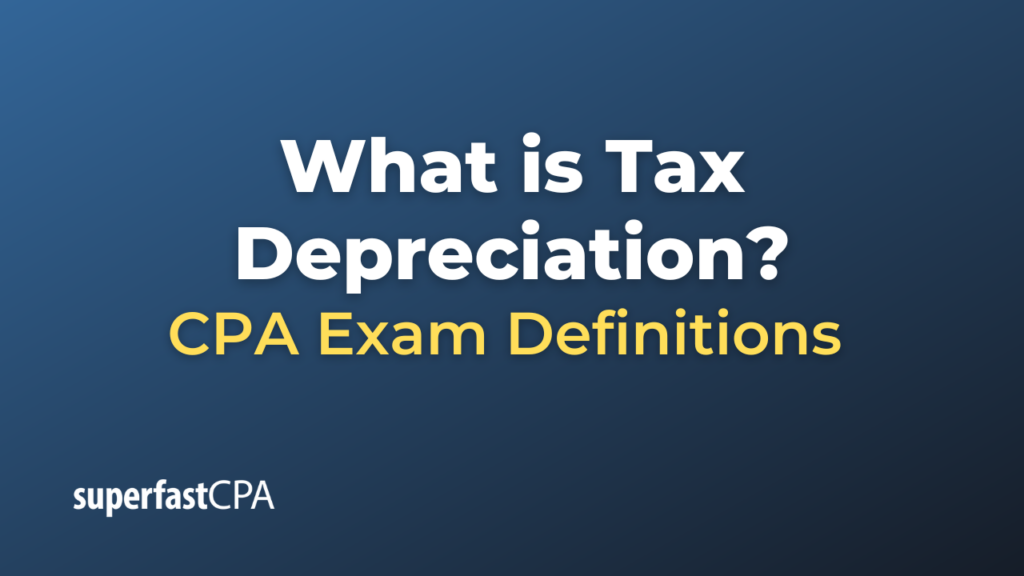Tax Depreciation
Tax depreciation refers to the depreciation of an asset’s value that can be deducted from taxable income for tax purposes. Depreciation represents the decline in the value of tangible assets over time due to wear and tear, obsolescence, or other factors. For tax purposes, rather than taking a single deduction for the asset’s cost in the year it’s acquired, the cost is spread out over the asset’s useful life through depreciation deductions.
Here are some key points about tax depreciation:
- Purpose: The main purpose of tax depreciation is to match the expense recognition of an asset with the revenue generated by that asset. It allows businesses to get a tax deduction for the tangible assets they buy and use in their operations over several years.
- Depreciable Assets: Not all assets can be depreciated for tax purposes. Typically, assets must have a useful life of more than one year, be used in a business or income-producing activity, and have a determinable useful life. Common depreciable assets include buildings, machinery, vehicles, and equipment.
- Methods: Different methods can be used to calculate depreciation for tax purposes:
- Straight-line method: This involves deducting the same amount every year over the asset’s useful life.
- Accelerated methods (like the Modified Accelerated Cost Recovery System – MACRS in the U.S.) : These allow for a higher depreciation expense in the earlier years of an asset’s life and less in the later years.
- Section 179 Deduction (specific to the U.S.): This provision allows businesses to deduct the full cost of qualifying assets in the year they are purchased and put into service, up to certain limits.
- Bonus Depreciation (also specific to the U.S.): This is an additional depreciation allowance that lets businesses immediately deduct a substantial percentage of the cost of certain assets in the year they are placed in service.
- Tax Lives : Each asset class has a defined “useful life” for tax purposes, which dictates how many years the asset can be depreciated over. For example, a building might be depreciated over 39 years, while certain equipment might be depreciated over 5 or 7 years.
- Limitations: There are specific rules and limits on how much can be depreciated each year, especially for assets like cars.
- Tax Planning Consideration: Businesses often consider tax depreciation rules when making decisions about capital expenditures, as the tax deductions can significantly impact cash flow and profitability.
In conclusion, tax depreciation provides a mechanism for businesses to recover the cost of capital assets over their useful lives by taking annual deductions against taxable income.
Example of Tax Depreciation
Let’s walk through a basic example of tax depreciation using the straight-line method, which is one of the simplest forms of depreciation.
Scenario:
Imagine a small business named “TechFlow” that purchases a piece of machinery for $100,000. The machinery is expected to have a useful life of 10 years, after which it will have no salvage value (i.e., it’s worth $0 after 10 years).
Using the straight-line method, the annual depreciation expense would be calculated as:
Annual Depreciation = Cost of the Asset – Salvage Value / Useful Life
Given:
- Cost of the Asset = $100,000
- Salvage Value = $0
- Useful Life = 10 years
Annual Depreciation = $100,000 – $0 / 10 = $10,000
This means that every year, for 10 years, TechFlow can deduct $10,000 from its taxable income as a depreciation expense for this machinery.
Tax Implication:
Assuming TechFlow falls under a 25% tax rate, the annual depreciation of $10,000 would result in tax savings of $2,500 each year:
Tax Savings = Depreciation Expense × Tax Rate
Tax Savings = $10,000 x 25% = $2,500
Thus, over the entire 10-year useful life of the machinery, TechFlow would realize total tax savings of $25,000 solely from the depreciation of this asset.
This example provides a simplified view of tax depreciation using the straight-line method. In practice, businesses often use more complex methods like MACRS in the U.S., which can result in faster depreciation rates and greater tax savings in the initial years of an asset’s life.













